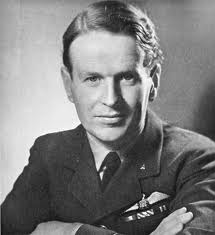
Back جون كونينجام (طيار من المملكه المتحده لبريطانيا العظمى و ايرلاندا) ARZ John Cunningham (aviateur) French ジョン・カニンガム Japanese
John Cunningham | |
|---|---|
 Wing Commander John Cunningham, 1942 | |
| Nickname(s) | Cat's Eyes |
| Born | 27 July 1917 Croydon, Surrey, United Kingdom |
| Died | 21 July 2002 (aged 84) Welwyn Garden City, Hertfordshire, United Kingdom |
| Allegiance | United Kingdom |
| Service/ | Royal Air Force (RAF) Royal Auxiliary Air Force (RAuxAF) |
| Years of service | 1936–1967 |
| Rank | Group captain |
| Unit | No. 604 Squadron RAF |
| Commands held | No. 85 Squadron RAF |
| Battles/wars | Second World War |
| Awards | Commander of the Order of the British Empire, Distinguished Service Order & two bars, Distinguished Flying Cross & bar, Mentioned in Despatches, Air Efficiency Award, Silver Star (United States), Order of the Patriotic War, 1st Class (USSR). |
John 'Cat's Eyes' Cunningham CBE, DSO & Two Bars, DFC & Bar, AE (27 July 1917 – 21 July 2002) was a Royal Air Force (RAF) night fighter ace during the Second World War and a test pilot.[1] During the war, he was nicknamed 'Cat's Eyes' by the British press to explain his successes and to avoid communicating the existence of airborne radar to the enemy.
Cunningham was born in Croydon in the southern United Kingdom, which at that time, was close to London's primary airport.[2] As a teenager, he was keen on entering the aviation industry. Temporarily abiding by his father's wishes for him to avoid the military, he approached the de Havilland company, and was accepted as an engineering candidate. Concurrently, he joined the Royal Auxiliary Air Force (RAuxAF) and became a member of No. 604 (County of Middlesex) Squadron. Cunningham began his training in August 1935, flew solo in March 1936 and received his wings in 1937. He gradually became an established test pilot, gaining considerable flying time on different types of aircraft.
In August 1939, Cunningham rejoined his squadron, now equipped with a version of the Bristol Blenheim. His observer was Jimmy Rawnsley, who would serve as his gunner and radio operator for most of the war, and contribute to all but three of his victories. In July 1940, the squadron was re-designated as a specialised night fighter unit, and was amongst the first to receive aircraft interception (AI) radar. Cunningham was promoted to squadron leader (Sqn Ldr) in September 1940.
On the night of 19 November 1940, Cunningham claimed his first victory. By the time the Blitz had ended in June 1941, he had destroyed thirteen enemy aircraft and claimed three as probable victories, and two damaged. After a prolonged rest period, he was promoted to wing commander (Wg Cdr) in 1942. He was also appointed to command No. 85 Squadron RAF, by which time, his tally had reached sixteen enemy aircraft destroyed. In 1943 and early 1944, he added a further four victories, one probable and one damaged. Cunningham's combat career ended with twenty aerial victories, three probable and six damaged. He spent the remainder of the conflict in various staff officer positions. By the end of the war in Europe in May 1945, he had attained the rank of group captain (Gp Cpt).[1]
After the war, Cunningham rejoined de Havilland, and continued his test pilot career. He flew the world's first jet airliner, the de Havilland Comet, in 1949.[1][2][3] He then flew commercial jets for a time in the early 1960s, and continued flying in the industry until the late 1970s. He also worked for British Aerospace (BAe) as executive director, retiring in 1980. In recognition of his wartime exploits and his contribution to civil aviation, he was appointed a Commander of the Order of the British Empire (CBE).
- ^ a b c Fountain, Nigel (29 July 2002). "John Cunningham: Wartime night-fighter hero and post-war Comet airliner test pilot". TheGuardian.com. Guardian News and Media Limited. Archived from the original on 7 April 2014. Retrieved 23 April 2023.
- ^ a b "John 'Cat's Eyes' Cunningham – wartime and test pilot". Harpenden-History.org.uk. Harpenden History – Home of the Harpenden and District Local History Society. n.d. Retrieved 24 April 2023.
- ^ Kingsley-Jones, Max (29 July 2019). "Retrospective: How the press missed the Comet's maiden flight". FlightGlobal.com. DVV Media International Limited. Retrieved 23 April 2023.
© MMXXIII Rich X Search. We shall prevail. All rights reserved. Rich X Search